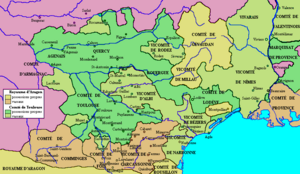User:Tomas Tso/沙盒
| 阿爾比十字軍 | |||||||
|---|---|---|---|---|---|---|---|
| 十字軍的一部分的一部分 | |||||||
 隆格多克的政治地圖 | |||||||
| |||||||
| 参战方 | |||||||
|
|
| ||||||
| 指挥官与领导者 | |||||||
|
|
| ||||||
| 伤亡与损失 | |||||||
| 至少200,000[1] 最多不超過 1,000,000[2] 卡特里派被殺害 | |||||||
| 許多歷史學家,包括創造種族滅絕新詞的拉斐爾·萊姆金,都認為是對卡特里派實施種族滅絕的行為[3][4][5][6][7][1] | |||||||
阿爾比十字軍或卡特裡派十字軍(1209年至1229年)教皇諾森三世發起為剷除卡特裡派(又稱阿爾比派),對法蘭西南部隆格多克發動的長達二十年的軍事討伐。十字軍主要是因法蘭西王室的指控,並迅速激起了政治的風向,結果不僅是信仰卡特裡派教徒人數顯著的減少,也是圖盧茲公國重組,使它進入法蘭西王室的領域並削弱了巴塞隆納公國高水準鮮明地域文化的影響力。
中世紀基督教激進的卡特裡派,十字軍直接討伐,起源於達爾馬提亞和保加利亞的波格米勒教會內,唯心二元宇宙觀的改革運動教派,回歸完美的基督教信息,貧困和宣教,尋求清心寡欲的生活。這個改革教派,大約於1145年傳入阿爾比,反對法蘭西南部天主教神職人員經常的醜聞和放蕩的生活方式。[8] 他們教派的一些主張和儀式,尤其是他們相信人的肉體是被魔鬼控制的,這與 道成肉身的基督及本質實體變換的教義相衝突,給他們帶來天主教教會的怒火。在12和13世紀時,因為在阿爾比城市周邊地區有許多追隨者,後來他們被稱為”阿爾比信徒”。[9]
在1022年到1163年期間,他們被當地八個教會理事會譴責,1179年在圖爾舉行第三次拉特朗公會議,會後宣佈所有的’’’阿爾比信徒’’’都”應被監禁,並處沒收財產” 。[10]英諾森三世的外交努力要求卡特裡派歸化正統的羅馬公教 [11]收效甚微。1208年1月14日,他的使節,皮埃爾·德·卡斯泰爾諾,被謀殺後,英諾森三世發動卡特裡派十字軍。他提供異端卡特裡派的土地給任何願意拿起武器的法蘭西貴族。初期成功後,法蘭西貴族面臨隆格多克普遍的起義,導致了法蘭西皇家軍隊的干預。
阿爾比十字軍在創建 道明會及制度化中世紀的宗教裁判所這兩件工作發揮了作用。
起源
[编辑]
12世紀,對教義持不同主張的組織團體,如瓦勒度福音教會和卡特里派(又稱為純潔派),出現在城鎮和新城市化的地區。他們的神學基本上是,其前身本來是羅馬帝國晚期中的摩尼教與基督教的混合,當時摩尼教並沒有全然消失。因東西方世界的接觸,包括東羅馬帝國皇帝將保羅派與波各米勒派從保加利亞地區逐出,這兩派就往西方傳去,又因著十字軍興起,使在西方還未消失的摩尼教再度興起,並且與這些傳入西方的派別融合,產生出卡特里派,影響範圍包括巴爾幹半島、北義大利及法國南部。[12]地中海西部的法蘭西,是當時歐洲城市化程度最高的地區之一,卡特裡派的成長代表受歡迎的群眾動向,[13][14]因而信眾蔓延到其他地區。相對較少的信徒接受”安慰禮” 成為純全信徒(perfect),但這風潮吸引了眾多的一般信徒(believers)、追隨者和同情者。
| 十字軍東征 |
| 第一次 | 第二次 | 第三次 | 第四次 | 第五次 | 第六次 | 第七次 | 第八次 | 第九次 | 北方十字軍 | 尼科波利斯十字軍 |
- ^ 1.0 1.1 Colin Martin Tatz; Winton Higgins. The Magnitude of Genocide. ABC-CLIO. 31 March 2016: 214. ISBN 978-1-4408-3161-4.
The papacy and the French king rounded out the Crusaders' genocidal achievements with their thirteenth-century Albigensian crusade against the Cathars in southern France—a rampage that resulted in some 200,000 more victims, and constituted yet another "completed" genocide.
- ^
http://necrometrics.com/pre1700a.htm#Albigensian (Accumulated by Matthew White
- John M. Robertson, A Short History of Christianity, London: Watts, 1902, p.254 ("It has been reckoned that a million of all ages and both sexes were slain.")
- Christopher Brookmyre, Not the End of the World (New York: Grove Press, 1998) p.39
- Max Dimont, Jews, God, and History, (New York: Penguin, 1994) p.225: 1,000,000 Frenchmen suspected of being Albigensians slain
- Dizerega Gus, Pagans & Christians: The Personal Spiritual Experience (St. Paul, MN: Llewellyn, 2001) p.195
- Helen Ellerbe, The Dark Side of Christian History (Orlando, FL: Morningstar & Lark, 1995) p.74
- Michael Newton, Holy Homicide (Port Townsend, WA: Loompanics Unlimited, 1998) p.117
- ^ Raphael Lemkin. Steven Leonard Jacobs , 编. Lemkin on Genocide. Lexington Books. 2012: 71 [14 February 2016]. ISBN 978-0-7391-4526-5.
- ^ Mark Gregory Pegg. A Most Holy War: The Albigensian Crusade and the Battle for Christendom. Oxford University Press. 2008: 195. ISBN 978-019988371-4.
- ^ Marvin, Laurence W. A Most Holy War: The Albigensian Crusade and the Battle for Christendom (review).. The Catholic Historical Review. October 2009, 95 (4): 801–802. doi:10.1353/cat.0.0546.
- ^ Kurt Jonassohn; Karin Solveig Björnson. Genocide and Gross Human Rights Violations: In Comparative Perspective. Transaction Publishers. : 50. ISBN 978-1-4128-2445-3.
The Albigensian Crusade was the first ideological genocide and it is included here because it gave rise to the Inquistion–an instutiton which developed many of the techniques of persecution that are still in wide use today.
- ^ Frank Robert Chalk; Kurt Jonassohn; Institut montréalais des études sur le génocide. The History and Sociology of Genocide: Analyses and Case Studies. Yale University Press. 1990: 114–138. ISBN 978-0-300-04446-1.
- ^ Frank Leslie Cross, Elizabeth A. Livingstone (editors), Oxford Dictionary of the Christian Church (Oxford University Press 2005 ISBN 978-0-19-280290-3), article "Cathari"
- ^ Merriam-Webster Dictionary: Albigenses
- ^ Weber, Nicholas. "Albigenses." The Catholic Encyclopedia. Vol. 1. New York: Robert Appleton Company, 1907. 14 Oct. 2013
- ^ VC Introduction: The historical background
- ^ The Voice of Pleasure: Heterosexuality Without Women by Anne Callahan. p. 32 [1]
- ^ VC §5
- ^ CCA §2
